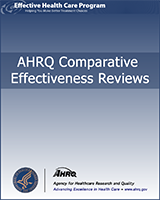NCBI Bookshelf. A service of the National Library of Medicine, National Institutes of Health.
This publication is provided for historical reference only and the information may be out of date.
Excerpt
The objective of this review is to provide a comprehensive synthesis of the evidence examining the effectiveness of nonoperative and operative interventions for the treatment of rotator cuff tears. The report is intended for a broad audience, including professional societies developing clinical practice guidelines, patients and their care providers, as well as researchers conducting studies on treatments of this condition. Outcomes of interest include health-related quality of life, shoulder function, time to return to work, cuff integrity, pain, range of motion and strength of the shoulder.
Contents
Prepared for: Agency for Healthcare Research and Quality, U.S. Department of Health and Human Services.1 Contract No. 290-02-0023. Prepared by: University of Alberta Evidence-based Practice Center.
Suggested citation:
Seida J, Schouten J, Mousavi S, Tjosvold L, Vandermeer B, Milne A, Bond K, Hartling L, LeBlanc C, Sheps D. Comparative Effectiveness of Nonoperative and Operative Treatment for Rotator Cuff Tears. Comparative Effectiveness Review No. 22. (Prepared by the University of Alberta Evidence-based Practice Center under Contract No. 290-02-0023.) AHRQ Publication No. 10-EHC050. Rockville, MD: Agency for Healthcare Research and Quality. July 2010. Available at: www.effectivehealthcare.ahrq.gov/reports/final.cfm.
This report is based on research conducted by the University of Alberta Evidence-based Practice Center (EPC) under contract to the Agency for Healthcare Research and Quality (AHRQ), Rockville, MD (Contract No. 290-02-0023). The findings and conclusions in this document are those of the author(s), who are responsible for its contents; the findings and conclusions do not necessarily represent the views of AHRQ. Therefore, no statement in this report should be construed as an official position of AHRQ or of the U.S. Department of Health and Human Services.
The information in this report is intended to help health care decision makers—patients and clinicians, health system leaders, and policymakers, among others—make well-informed decisions and thereby improve the quality of health care services. This report is not intended to be a substitute for the application of clinical judgment. Anyone who makes decisions concerning the provision of clinical care should consider this report in the same way as any medical reference and in conjunction with all other pertinent information, i.e., in the context of available resources and circumstances presented by individual patients.
This report may be used, in whole or in part, as the basis for development of clinical practice guidelines and other quality enhancement tools, or as a basis for reimbursement and coverage policies. AHRQ or U.S. Department of Health and Human Services endorsement of such derivative products may not be stated or implied.
None of the investigators have any affiliations or financial involvement that conflicts with the material presented in this report.
- 1
540 Gaither Road, Rockville, MD 20850. www
.ahrq.gov
- Review Nonoperative and Operative Treatments for Rotator Cuff Tears: Future Research Needs: Identification of Future Research Needs From Comparative Effectiveness Review No. 22[ 2013]Review Nonoperative and Operative Treatments for Rotator Cuff Tears: Future Research Needs: Identification of Future Research Needs From Comparative Effectiveness Review No. 22Butler M, Forte M, Braman J, Swiontkowski M, Kane RL. 2013 Feb
- Shoulder strength with rotator cuff tears. Pre- and postoperative analysis.[Clin Orthop Relat Res. 1993]Shoulder strength with rotator cuff tears. Pre- and postoperative analysis.Kirschenbaum D, Coyle MP Jr, Leddy JP, Katsaros P, Tan F Jr, Cody RP. Clin Orthop Relat Res. 1993 Mar; (288):174-8.
- A randomized clinical trial comparing open to arthroscopic acromioplasty with mini-open rotator cuff repair for full-thickness rotator cuff tears: disease-specific quality of life outcome at an average 2-year follow-up.[Am J Sports Med. 2008]A randomized clinical trial comparing open to arthroscopic acromioplasty with mini-open rotator cuff repair for full-thickness rotator cuff tears: disease-specific quality of life outcome at an average 2-year follow-up.Mohtadi NG, Hollinshead RM, Sasyniuk TM, Fletcher JA, Chan DS, Li FX. Am J Sports Med. 2008 Jun; 36(6):1043-51. Epub 2008 Mar 19.
- Review Surgical and nonsurgical management of rotator cuff tears.[Arthroscopy. 2002]Review Surgical and nonsurgical management of rotator cuff tears.Ruotolo C, Nottage WM. Arthroscopy. 2002 May-Jun; 18(5):527-31.
- Functional outcome of arthroscopic repair with concomitant manipulation in rotator cuff tears with stiff shoulder.[Am J Sports Med. 2008]Functional outcome of arthroscopic repair with concomitant manipulation in rotator cuff tears with stiff shoulder.Cho NS, Rhee YG. Am J Sports Med. 2008 Jul; 36(7):1323-9. Epub 2008 Jun 6.
- Comparative Effectiveness of Nonoperative and Operative Treatments for Rotator C...Comparative Effectiveness of Nonoperative and Operative Treatments for Rotator Cuff Tears
- CHC1 clathrin heavy chain [Saccharomyces cerevisiae S288C]CHC1 clathrin heavy chain [Saccharomyces cerevisiae S288C]Gene ID:852666Gene
Your browsing activity is empty.
Activity recording is turned off.
See more...
